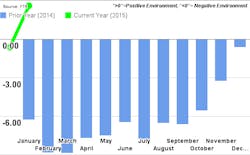Happy Days Are Here Again (for a little while, anyway)
That huge sigh of relief you might have just heard is the entire shipping community reacting to the news that the Shippers Conditions Index has finally reached a positive reading. The SCI, a measurement tool created by transportation analyst firm FTR, is a compilation of factors affecting the shippers transport environment. Any reading below zero indicates a less-than-ideal environment for shippers, and the SCI had been well below zero for the past several years, since 2010. But no more—the SCI score for January 2015 was 2.6.
That positive score reflects a one month reaction to fuel price reductions and adjustment for reversal of the 2013 Hours of Service changes, FTR hastens to point out. And the party could well be short-lived, as FTR anticipates that the SCI will fall back into neutral territory and deteriorate as the year progresses, impacted by building regulatory drag, continued freight growth, and upward fuel pricing that could be substantial by mid-year.
“It is tough for a shipper to get a solid view of the underlying costs for truck transportation due to three main factors,” says Jonathan Starks, FTR’s director of transportation analysis. “First, the dramatic drop in fuel price has led to an all-in cost (on a per-mile basis) nearly equal to last year’s. After telling management for the last year to expect strong increases in transport costs, they now show a near-neutral impact on the bottom line.”
Another factor is truckload rates which, Starks points out, aside from the drop in fuel, are still increasing. “Contract rates (excluding fuel) were up 5-7% versus last year to start 2015.
A third factor, according to Starks, “is the skewed nature of the 2014 data due to the weather-induced capacity crunch of the Polar Vortex. This had the effect of raising rates and delaying shipments. The impact was much more visible in the spot market where rates rose 20% and capacity tightness was at levels never before seen. Data from Truckstop.com shows that their Market Demand Index (MDI) averaged 21.2 during 2014, a level that was 45% higher than 2013. We have not had those pressures this winter, and the MDI is back to levels seen during 2013. This is making year-over-year comparisons difficult to use as a reflection of where the market is moving.”
It’s certainly a good thing that the market has removed several obstacles to improve the lot of shippers, but Starks expects that the market “will quickly move back toward a negative environment as freight growth continues and regulations are enacted that make capacity tight again, moving base rates higher. There is also a strong potential for reversal of the recent reductions in fuel prices. All of these factors point toward a notable decline during the rest of 2015.”

